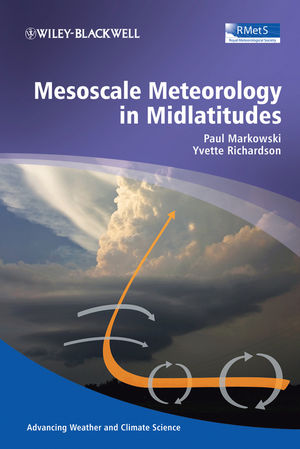Mesoscale Meteorology in MidlatitudesISBN: 978-0-470-74213-6
Hardcover
432 pages
February 2010
 |
||||||
Series Foreward xi
Preface xiii
Acknowledgments xv
List of Symbols xvii
PART I General Principles 1
1 What is the Mesoscale? 3
1.1 Space and time scales 3
1.2 Dynamical distinctions between the mesoscale and synoptic scale 5
2 Basic Equations and Tools 11
2.1 Thermodynamics 11
2.2 Mass conservation 16
2.3 Momentum equations 17
2.4 Vorticity and circulation 21
2.5 Pressure perturbations 25
2.6 Thermodynamic diagrams 32
2.7 Hodographs 34
3 Mesoscale Instabilities 41
3.1 Static instability 41
3.2 Centrifugal instability 48
3.3 Inertial instability 49
3.4 Symmetric instability 53
3.5 Shear instability 58
PART II Lower Tropospheric Mesoscale Phenomena 71
4 The Boundary Layer 73
4.1 The nature of turbulent fluxes 73
4.2 Surface energy budget 82
4.3 Structure and evolution of the boundary layer 83
4.4 Boundary layer convection 88
4.5 Lake-effect convection 93
4.6 Urban boundary layers 103
4.7 The nocturnal low-level wind maximum 105
5 Air Mass Boundaries 115
5.1 Synoptic fronts 117
5.2 Drylines 132
5.3 Outflow boundaries 140
5.4 Mesoscale boundaries originating from differential surface heating 149
6 Mesoscale Gravity Waves 161
6.1 Basic wave conventions 161
6.2 Internal gravity wave dynamics 165
6.3 Wave reflection 170
6.4 Critical levels 172
6.5 Structure and environments of ducted mesoscale gravity waves 173
6.6 Bores 175
PART III Deep Moist Convection 181
7 Convection Initiation 183
7.1 Requisites for convection initiation and the role of larger scales 183
7.2 Mesoscale complexities of convection initiation 189
7.3 Moisture convergence 195
7.4 Elevated convection 197
8 Organization of Isolated Convection 201
8.1 Role of vertical wind shear 201
8.2 Single-cell convection 206
8.3 Multicellular convection 209
8.4 Supercellular convection 213
9 Mesoscale Convective Systems 245
9.1 General characteristics 245
9.2 Squall line structure 249
9.3 Squall line maintenance 253
9.4 Rear inflow and bow echoes 260
9.5 Mesoscale convective complexes 265
10 Hazards Associated with Deep Moist Convection 273
10.1 Tornadoes 273
10.2 Nontornadic, damaging straight-line winds 292
10.3 Hailstorms 306
10.4 Flash floods 309
PART IV Orographic Mesoscale Phenomena 315
11 Thermally Forced Winds in Mountainous Terrain 317
11.1 Slope winds 317
11.2 Valley winds 320
12 Mountain Waves and Downslope Windstorms 327
12.1 Internal gravity waves forced by two-dimensional terrain 327
12.2 Gravity waves forced by isolated peaks 332
12.3 Downslope windstorms 333
12.4 Rotors 342
13 Blocking of the Wind by Terrain 343
13.1 Factors that govern whether air flows over or around a terrain obstacle 343
13.2 Orographically trapped cold-air surges 346
13.3 Lee vortices 351
13.4 Gap flows 358
PART V Appendix 367
A Radar and Its Applications 369
A.1 Radar basics 369
A.2 Doppler radar principles 371
A.3 Applications 374
References 389
Index 399



